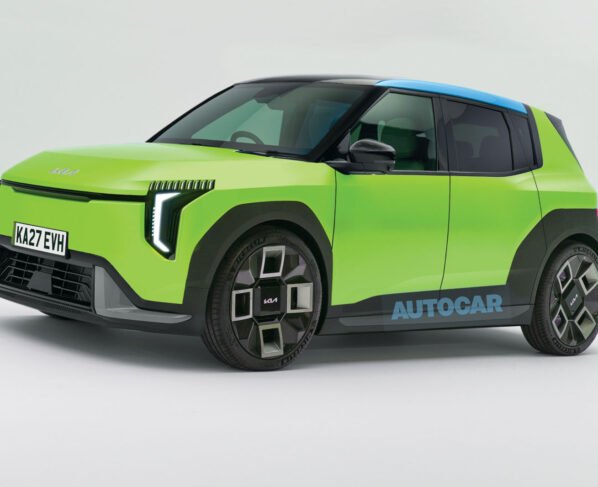Boss says non-EV powertrains are also needed to meet global demand
The next wave of Kia EVs is being prepared for launch by the end of the decade, among them an entry-level model as well as a next-generation architecture that will underpin replacements for the likes of the EV6 and EV9.
Kia’s rollout of electric cars continues apace, with the current EV3, EV6 and EV9 being joined this year by the EV4 and EV5, followed by the EV2 in 2026. Now the firm’s efforts are focused on what comes next.
An entry-level EV that sits below the EV2 and is priced below €25,000 (about £21,000) is the major new addition, but replacements for the EV6 and EV9 will mark step-changes for the brand as it moves to software-defined vehicles (SDVs).
New range-extender EV technology is also in the works, alongside continued development of hybrids and even internal-combustion-engined models as Kia plans to continue offering a whole range of vehicles that is now expanding beyond cars and into vans and pick-ups for the first time.
Smaller Kias coming
Kia president and CEO Ho Sung Song confirmed his commitment to entry-level models and keeping his cars affordable and accessible, and to that end suggested a baby Kia is deep into its development.
Song said Kia was in no rush to replace the current Picanto city car, which is still selling well in Europe, and the strength of Kia’s electric car range means the firm isn’t under any imminent pressure from the CO2 regulations that have doomed other city cars on the market in recent years.
The Picanto, heavily updated in 2023, would therefore remain on sale up until the point that Kia was able to create an entry-level electric city car for less than €25,000. The brand feels it is important to keep such an affordable entry-level model in its range.
Song said the mooted entry-level EV was “homework” for Kia at the moment, and a sub-€25,000 model was “one area we are studying and developing”.
![]()
Given Song’s comments, it seems inevitable that when the Picanto does reach the end of its life – which is expected to be before the end of the decade – it will be replaced by the entry-level EV rather than an ICE model. Yet there is a scenario in which the two models are sold alongside each other, depending on how CO2 rules develop. Other car makers have already taken this approach.
Kia design director Karim Habib said the firm was looking at Japanese brand Muji for inspiration for its smaller cars. The clothing and homeware retailer focuses on simplicity and utility, and Kia was exploring how to “reduce things to their very essence and still have a desirability to them”.
Habib said this work also included customisation and “how you design something super-basic that you can customise or individualise for different types of customers”. He added: “In our view, that’s where it can be really interesting in a lower-end price bracket.”
Software-defined vehicles
Kia is preparing to embrace SDVs and launch a new architecture for its larger models using the technology. SDVs move a car away from having a host of different subsystems to just a few core systems that are all centrally integrated.
The approach allows for greater stability and reliability for the car. It is also easier to update and manage across multiple vehicles, because they all share the same ‘brain’. Song said this would allow Kia to decouple hardware and software development and allow shorter development times.
He added that development work on a new SDV architecture had been ongoing for some three years and a pilot project concept may be shown next year. That is a reference to the ‘SDV Pace Car’ that Kia confirmed earlier this year and which is the development mule for this project.
Following this timeline through to production would fit with Kia launching an EV6 replacement off this new 800V architecture. A second-generation EV9 should also be due by the end of the decade.
Further benefi ts for future Kias from SDVs will be more personalised user interfaces inside customers’ vehicles and “frequent upgrading of software to give them freshness for their vehicle”, according to Song, who said it could help bring down the costs of cars because “our development cycle is shorter so the cost is much cheaper”.
Song added: “Because we are decoupling hardware and software, we can be more flexible making different kinds of vehicles based on the same platform.”
Kia will also introduce learnings from its new range of ‘PBV’ vans into the development of its future cars, particularly around the integration of software and hardware. The PV5, Kia’s first van, will be followed by a larger PV7 van in 2027 and a PV9 in 2029.
Hybrid and range-extender powertrains
Song said Kia will continue to invest in all relevant powertrain technologies because it is a global car maker responding to different market demands.
Song is a firm believer in the switch to EVs and believes that in Europe in particular Kia can “drive volume from a full EV line-up” that is “very complete” thanks to a “strong trend” towards EVs in the market, but Kia is remaining flexible in its approach.
“The final destination in Europe is EVs, which is why I want to be a very strong EV player in Europe,” said Song. “But if we look at worldwide demand we should have alternative powertrains, like hybrids, plug-in [hybrids] and EREVs [extended-range electric vehicles, aka RExs].”
He said range-extender technology was particularly interesting for larger, heavier vehicles to which pure EV technology was less well suited. The first REx Kia is expected be to launched by the end of the decade as part of an evolution of the car maker’s hybrid offering for larger models.
Combustion engines will continue to be important for emerging markets like North Africa where “they don’t have the infrastructure” for electrification. To that end, Song is not putting an end date on Kia’s development of internal combustion engines.
Future design
Kia is already planning a new evolution for the design of its models, and Song said he recognises the importance of staying ahead and maintaining innovation in this area.
He added: “Design is one of the highest preferences for our customers buying our cars, but today’s design philosophy has already been in the market for five years. We continually think about how to renew it.
“If we repeat again and again [with the same design], maybe customers will feel it is boring, so we have to think about how to renew vehicles. We will continue to study what can be improved and renewed for our customers.”
Habib confirmed that concept cars would continue to be shown by Kia, adding that the firm was likely to unveil one later this year, although he didn’t confirm any specifics.
Future innovations
A rollout of an AI assistant in all of Kia’s new vehicles is also on the way, to better control a car’s wider functions and introduce “more innovation” to future Kias, according Song.
He added: “Customers are expecting more innovation in our vehicles. They are experiencing all-new functions from smartphones. They want the same in our vehicles.” Song said Kia has to be “more innovative” in providing new features in vehicles, and Kia is working with more partner companies, including Samsung, to help it do so.
Kia will also continue to invest in the development of full autonomous driving, which Song believes will “definitely be for the convenience of the customers in the future”. This approach will be baked into the SDV architecture in development.





